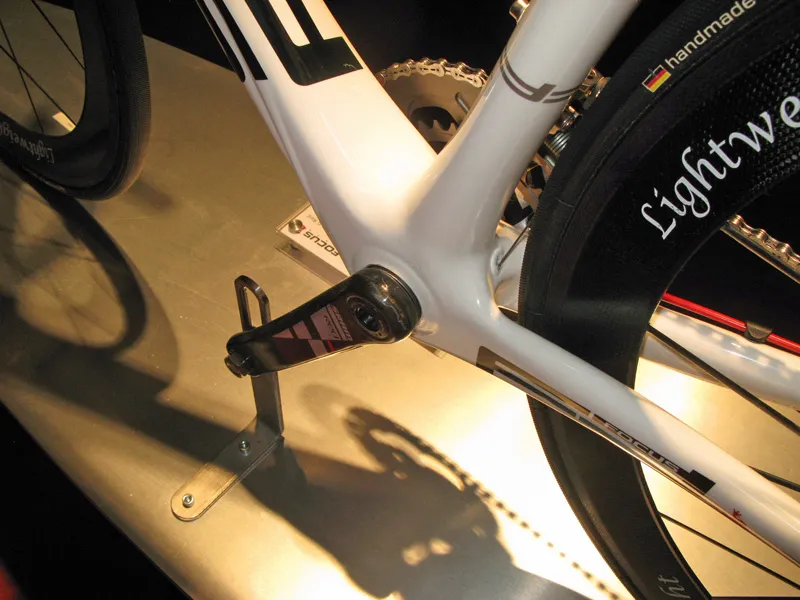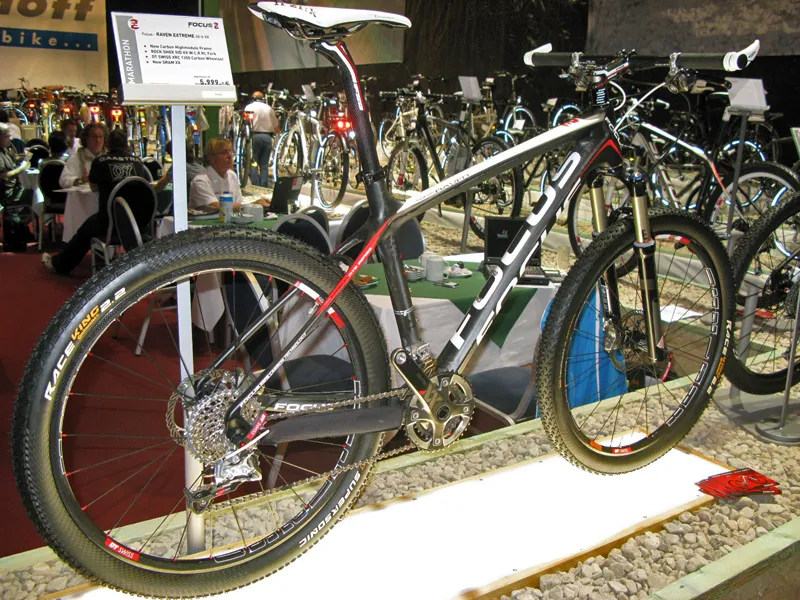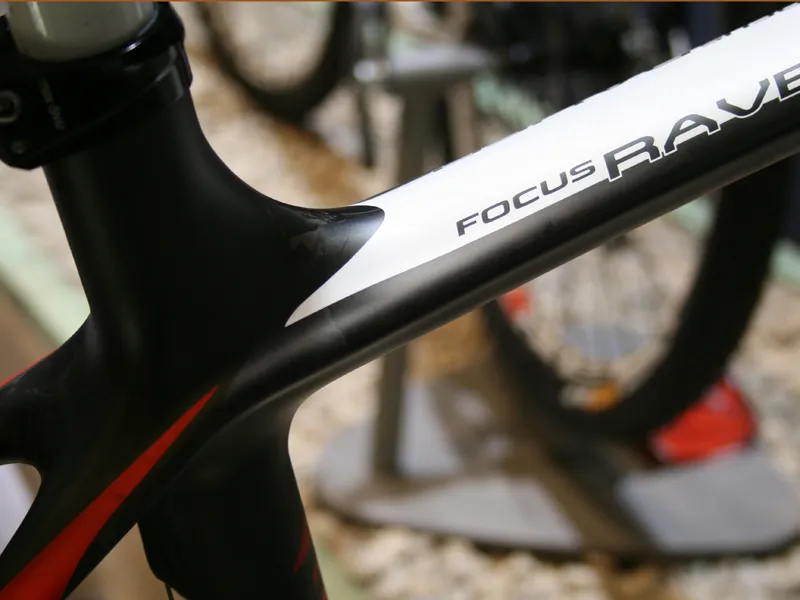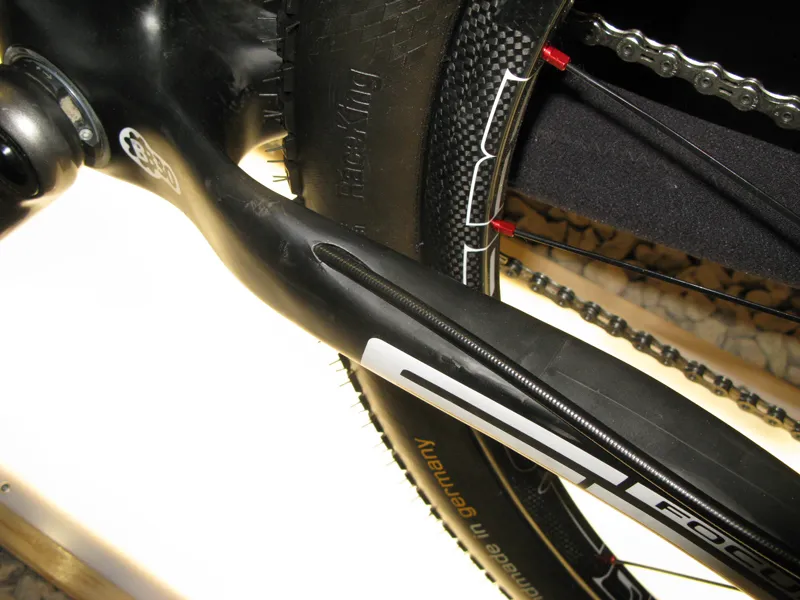German bike makers Focus have unveiled their 2010 range, which includes no fewer than 15 new frames including revamped Izalco and Cayo road bikes; updated Raven hardtail and FIRST suspension mountain bikes; and Focus’s first electric bikes.
Focus turn out to be surprisingly huge. If you think of them as a small niche operation doing good-quality value-for-money bikes, then a visit to their factory in Cloppenburg, Germany instantly blows that notion away.
They are part of Derby Cycle, who also own Kalkhoff, Rixe, Univega amd Diamondback, as well as making the German versions of Raleigh bikes. Across 10 production lines the factory assembles around 3,500 bikes per week, making Derby Europe’s biggest single-site bike maker.
With the resources of a company this large behind Focus, it’s no surprise that the bikes have developed rapidly in the past few years.
New Izalco reflects pro feedback
The Izalco road race bike is perhaps the best example of this. Focus went racing in the ProTour for the first time this year, supplying bikes to Milram. Like so many companies before them, they have found that the pros’ requirements are demanding, and according to product manager Jorg Arenz, the bike has been improved thanks to feedback from the team.
Some changes are not surprising – the top model uses high modulus carbon now and is claimed to be lighter and stiffer as a result – but others are slightly less obvious.

Focus have revised their top-end Izalco road bike for 2010 with the help of the Milram squad
Among other changes, the Izalco now has a tapered head tube – 1 1/8in at the top, 1 1/4 at the bottom – for better handling; internal cable routing; BB30 bottom bracket; and a reinforced top tube.
With input from Milram, the internal cable routing has been carefully designed to guide the cables in smooth curves and – importantly from a pro mechanic’s perspective – the cables are easy to replace because they run in tubes moulded into the carbon fibre. Anyone who has battled to replace an internal cable on some older frames will breathe a sigh of relief.

The 2010 Focus Izalco comes with a tapered head tube and reinforced top tube
You might wonder why a race frame needs a reinforced top tube, but Arenz explained that these bikes get a hard life, and that Focus had seen crash failures caused by handlebar impacts on the top tube. A few extra grams of carbon in this area makes an expensive frame more likely to survive a crash.
The 2010 Izalco drops seatpost size to 27.2mm. Pro-grade carbon bikes have become so stiff that they are uncomfortable on very long rides, explained Arenz, so going to a slightly more flexible post puts some comfort back.
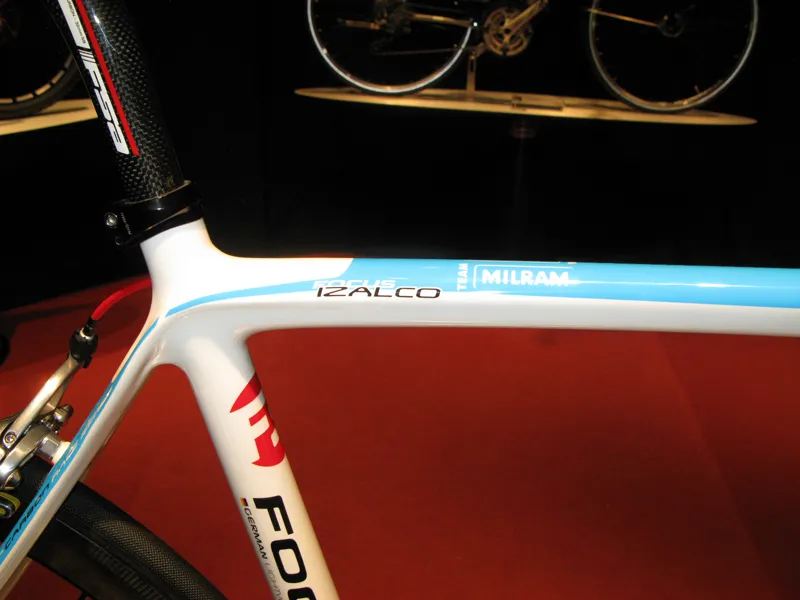
The 2010 Izalco comes with a 27.2mm seatpost for added comfort on long rides
Also driven by comfort is the extra tyre clearance on the 2010 Izalco. For two weeks of the Tour, the Milram team used 25mm tyres. Arenz says he thinks the tide is turning away from very narrow tyres to the better comfort and road-holding of slightly fatter rubber.
There will be two grades of Izalco frame. The Team Milram and Extreme versions get Focus’s new high modulus carbon for a frame weight under 1,000g, while the other models use UD carbon.
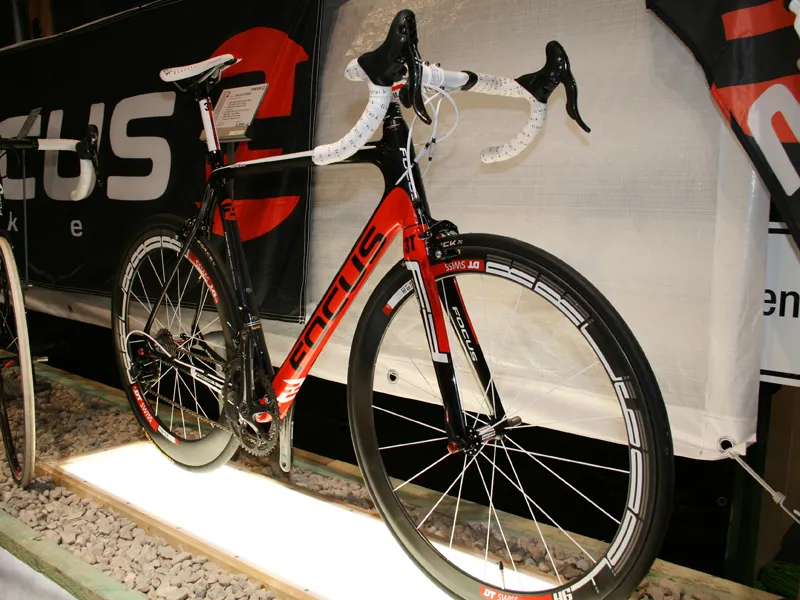
The Extreme model gets the same high modulus frame as the team edition
Below the Izalco, Focus’s popular Cayo range also gets a makeover with an all-new carbon frame. Cayo features include a tapered head tube like the Izalco’s; tube diameters that vary with frame size; BB30 bottom bracket; and carbon fibre dropouts.
The frame weighs in at 1,280g, according to Focus, and it’s a classic example of yesterday’s top-end technology trickling down to bikes most of us can afford.
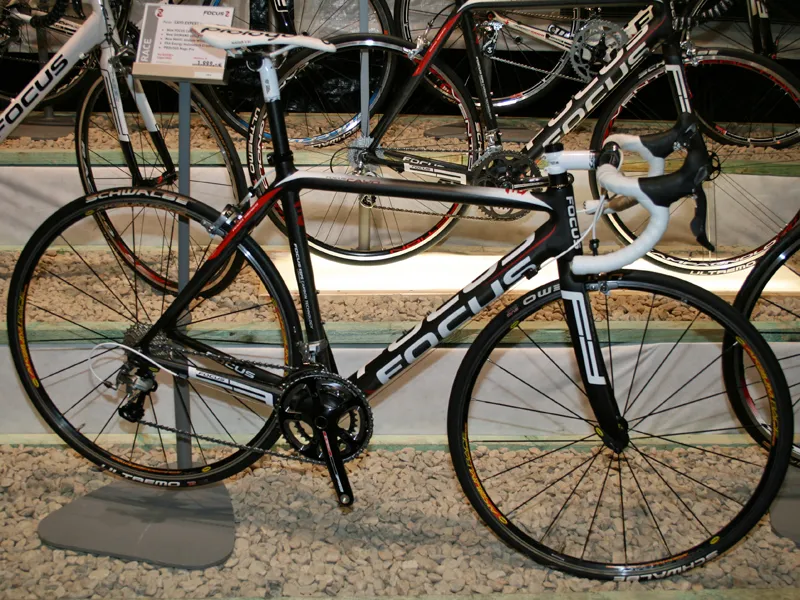
The Cayo gets an all-new carbon frame with trickle-down technology from the Izalco
Who’s on FIRST?
Focus have been busy off road too. For starters, the third generation of the FIRST suspension bike with the shock mounted in the top tube has shed 500g from the frame while going to a 1 1/8-to-1 1/2 in head tube, 120mm of travel and carbon fibre rear subframe. With a CrankBrothers Joplin adjustable seatpost, the FIRST Extreme weighs just 11.6kg (25.5lb), according to Focus.

The 120mm-travel FIRST Extreme weighs just 11.6kg, including adjustable seatpost
The bike that’s chasing the Izalco on the roadside dirt track, though, is the new Raven hardtail. Like the Izalco it boasts tidy internal cable routing, and a very nicely done internal hose for the rear brake. The rear brake mount has been moved to the chainstays and Focus say this is a first: a fully-integrated post mount on the chainstay.
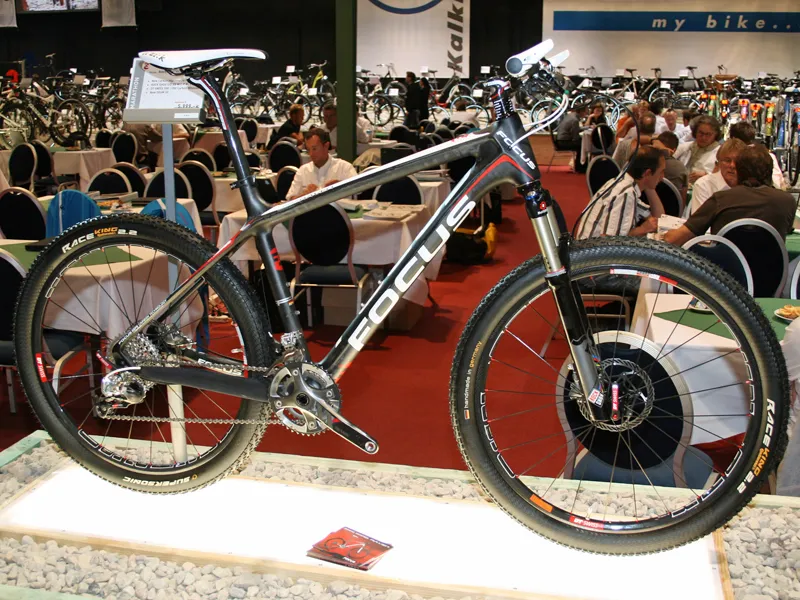
The Raven Extreme carbon hardtail features tidy internal cable/hose routing
Moving the brake has allowed Focus to thin down the seatstays in a move that’s reminiscent of the design of many top road frames, and – again like the Izalco – the new Raven has room for fatter tyres. Focus say 2.4in rubber will fit, so this bike can be set up as a cross-country race rig or as a very light but sturdy trail basher.
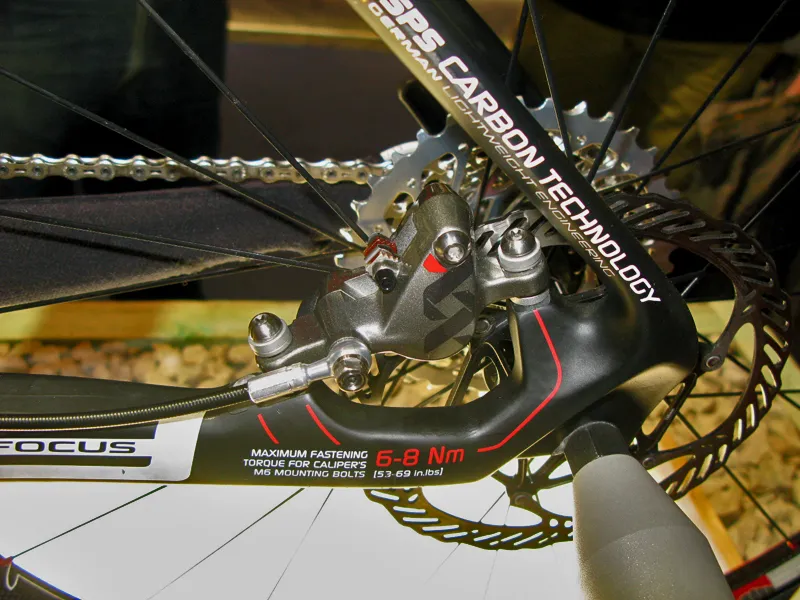
The 2010 Raven's standout feature is the disc brake post mount on the chainstay
With SRAM’s new XX group, the Raven Extreme is claimed to weigh 8.4kg (18.5lb). Arenz says they could have gone lighter by throwing featherweight components at this bike, but “we wanted to leave room to tinker”.
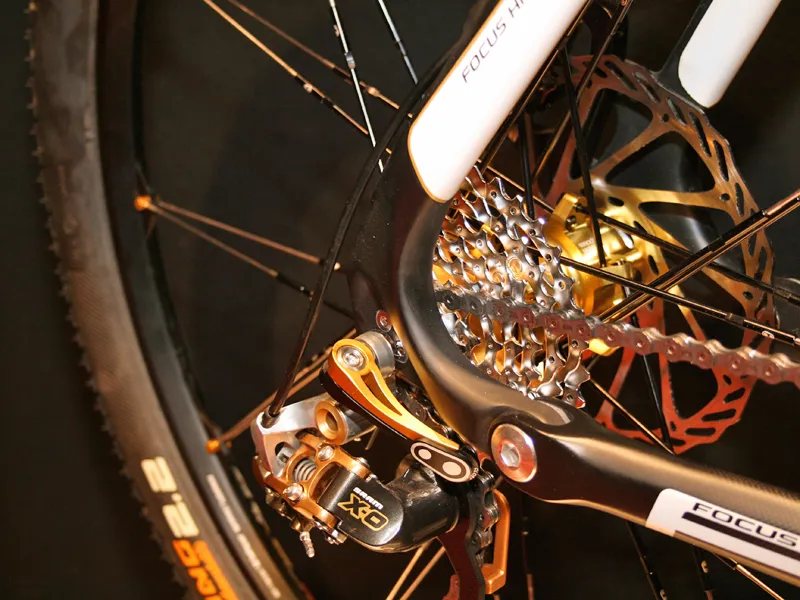
The Raven comes with SRAM's new XX 10-speed groupset and weighs in at 8.4kg
Focus’s other suspension bikes also get new bones. The 100mm-travel Super Bud has a new hydroformed aluminium frame with 1 1/8in-to-1 1/2in tapered head tube and what Focus call 'east Access bearing System'. This makes the main pivot bearings accessible from the non-drive side even if there’s a crank fitted for easy adjustment and maintenance. The Super Bud also gets new tube shapes with flares at the head tube to stiffen this area.

The 100mm-travel Focus Super Bud has a new hydroformed aluminium frame
At 140mm rear travel, the Thunder line is Focus’s all-mountain entry. It shares the unusual Knuckle Box rocker design with Diamondback, which is why – unlike other Focus suspension bikes – it’s a single-pivot design instead of a four-bar with a Horst link.
That feature is shared with the 150mm rear travel Project bikes, and both Project and Thunder models get 1 1/8in-to-1 1/2in tapered head tubes.
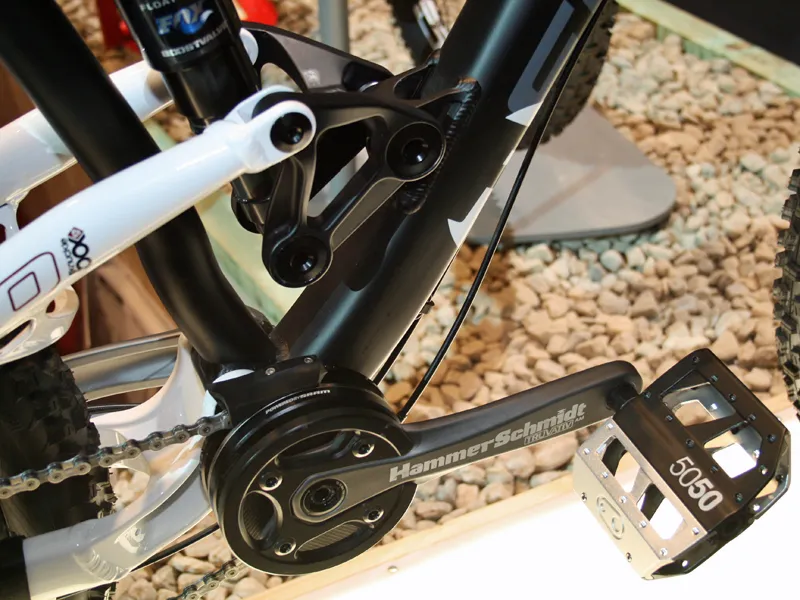
The Thunder and Project models share the same 'Knuckle Box' rocker design
Focus gets electrified
Derby Cycle are also making a big investment in electric bikes and the Focus range includes a couple of battery-assisted models. They’re not necessarily of interest to your average hardcore road cyclist or mountain biker, but a quick spin on the new Kalkhoff Pro Connect S – which shares the same 300W motor as the new Focus Jarifa Speed – revealed it to be startlingly fun, and startlingly quick.
Focus say these 300W bikes are capable of 40km/h (25 mph) in the unrestricted form in which they’re sold in Europe. That’s the power output of a decently fit rider, and even if the motor and battery add a few kilograms, you still come out well ahead.
For older riders, and for folks who want to ride to work in office clothes, get there fairly quickly and not arrive in a puddle of sweat, electric bikes really look like a viable option.



